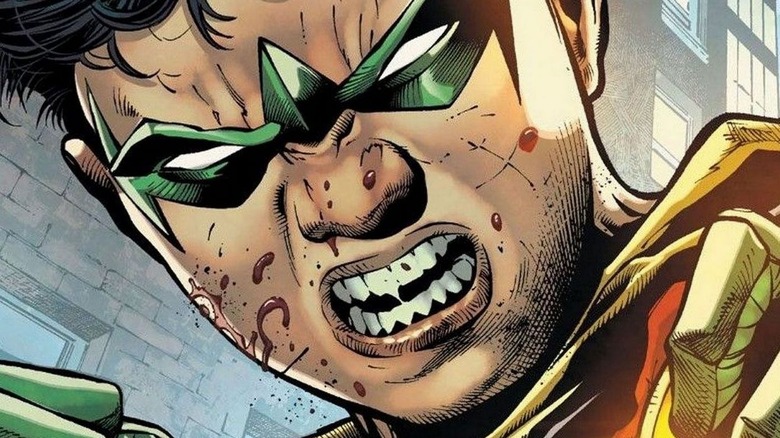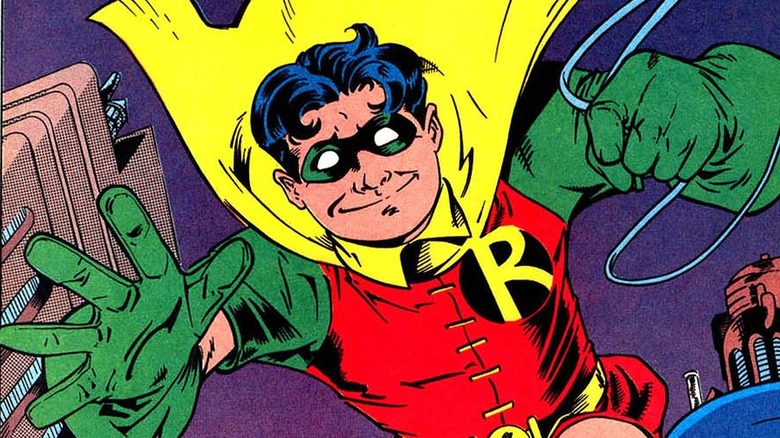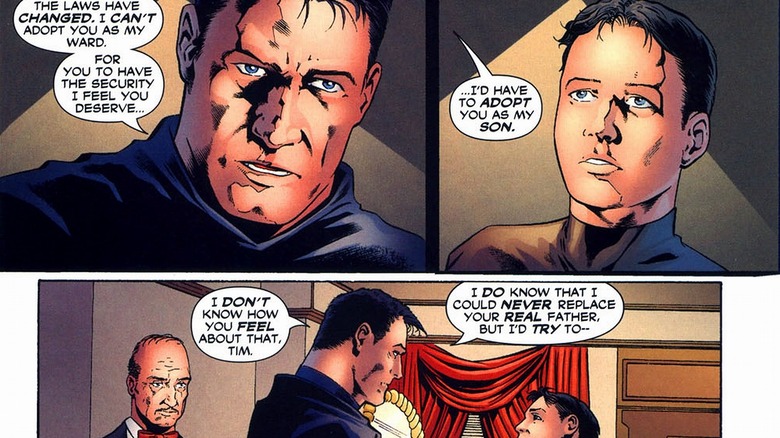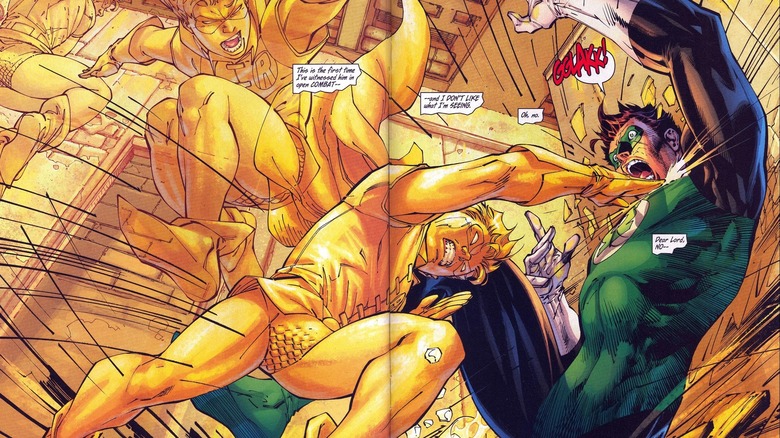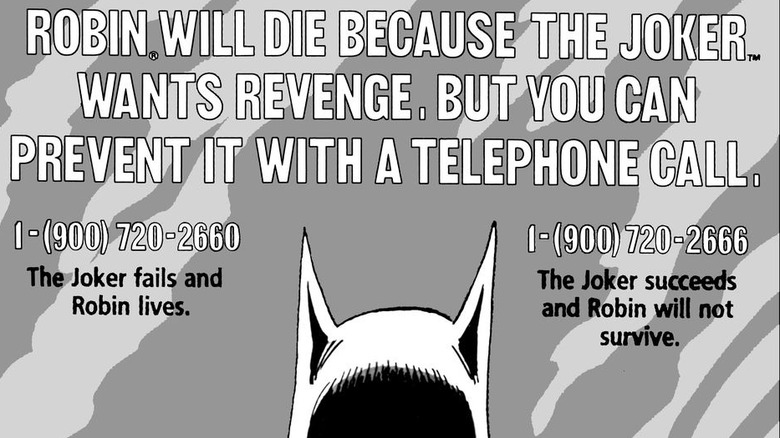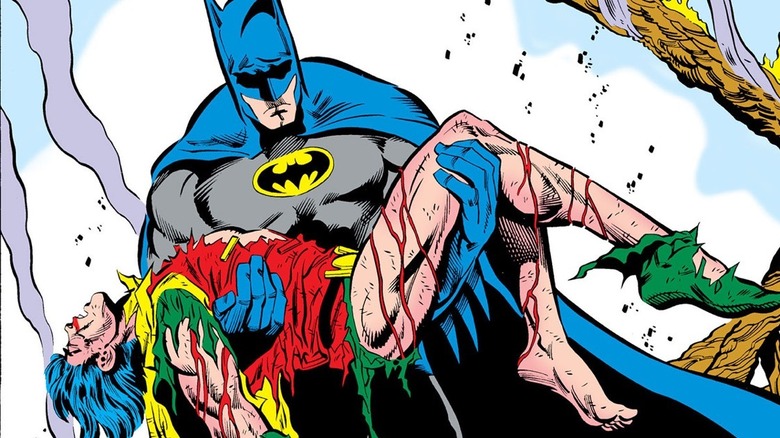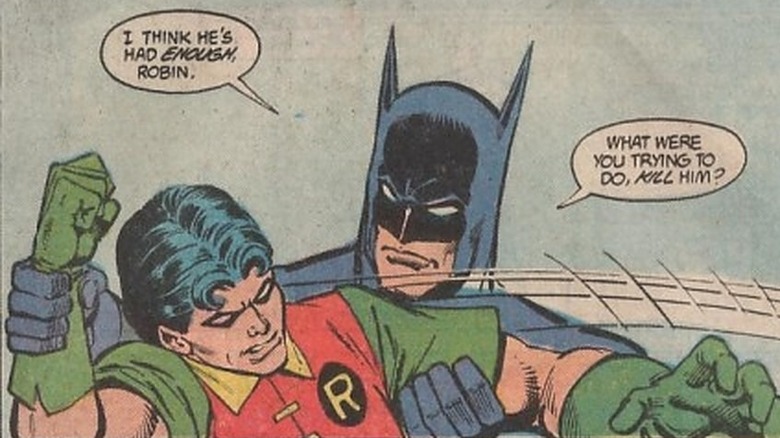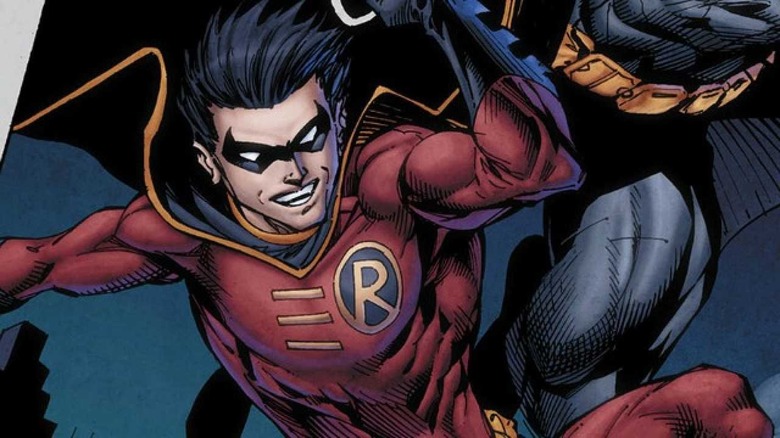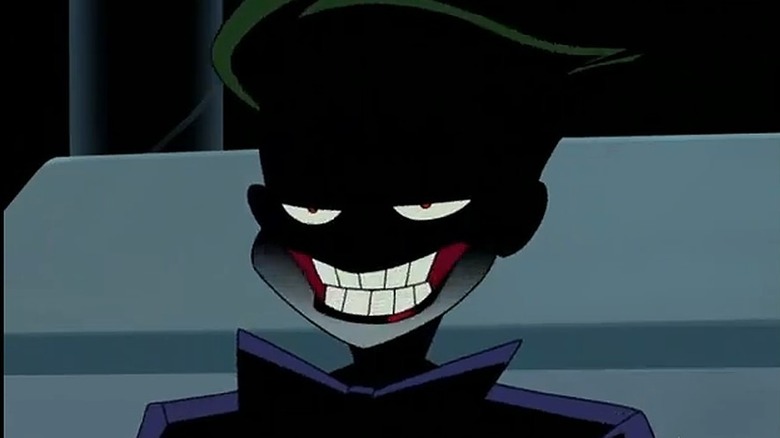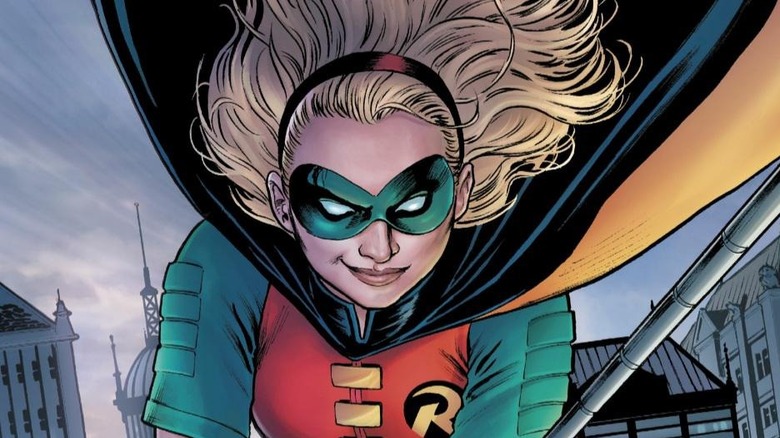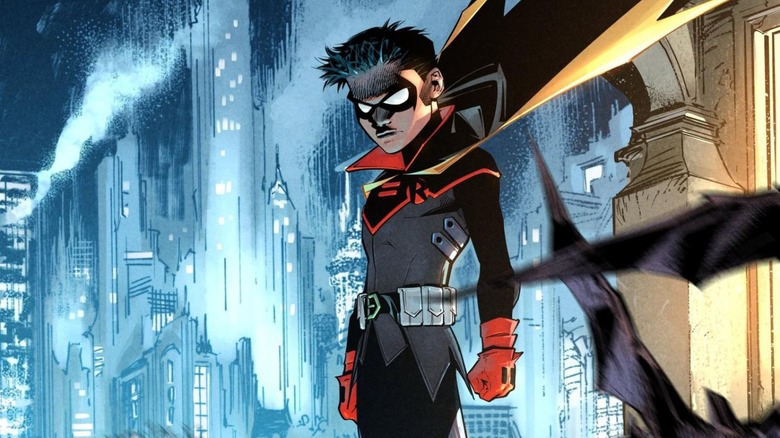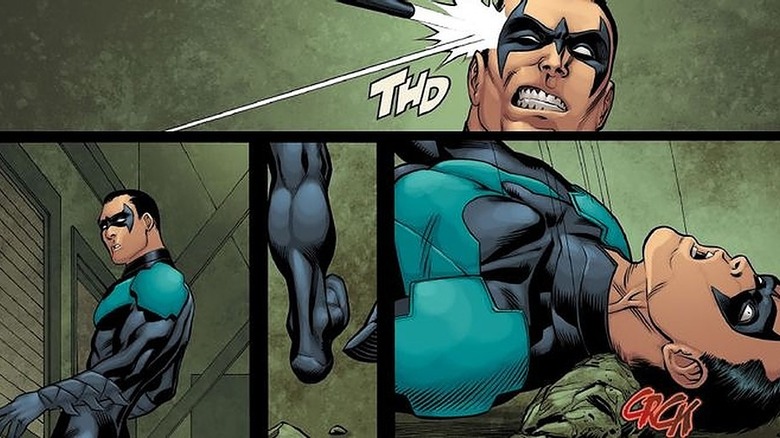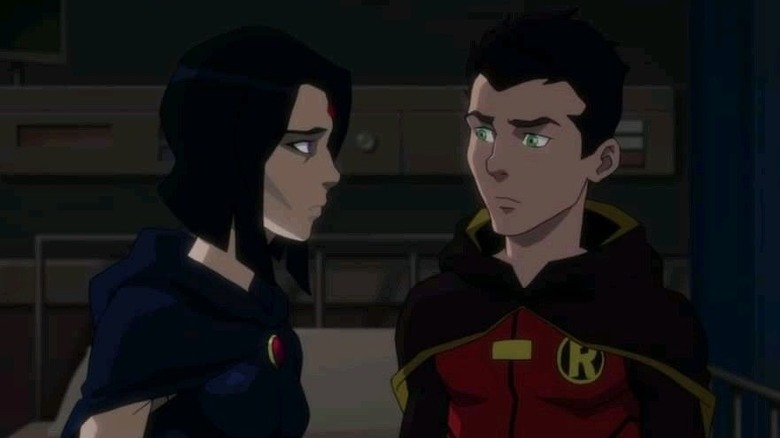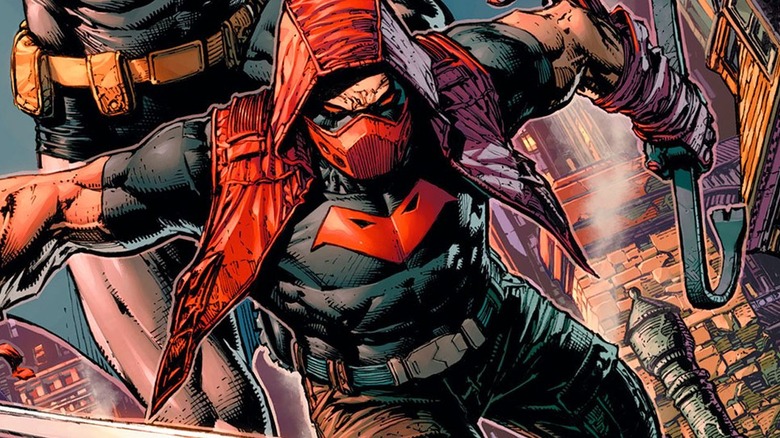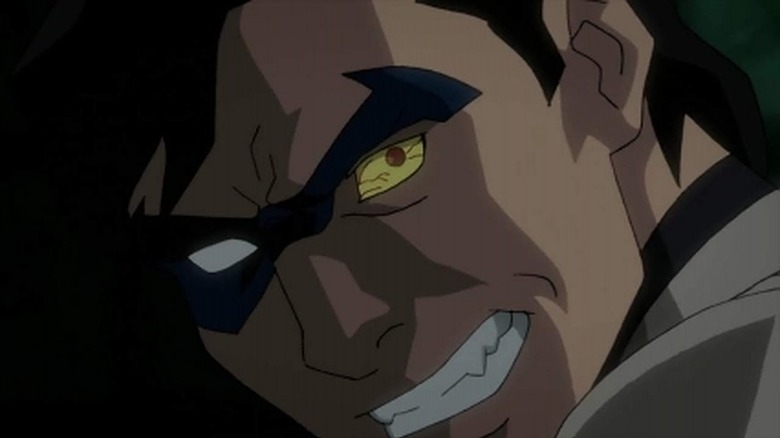The Dark History Of DC's Robin
He's named after a bird that symbolizes hope, renewal, and rebirth, which is weirdly fitting since the hapless hero seems to die and be reborn with alarming frequency. Yup, it's Robin, the Boy Wonder, indispensable (though still disposable) sidekick to Batman, Gotham's Caped Crusader.
Of course, throughout his run in the comics and films — both animated and live-action — Robin serves as so much more than just a sidekick. At one point, a former Robin takes up the cowl to become the new Dark Knight himself. Other evolutions see Robin as the leader of the crime-fighting team the Teen Titans or as the hero Nightwing, who himself has appeared in various forms and was originally based on an identity assumed by Superman.
With all of his iterations, the hero Robin and the human being who wore his uniform have contributed to an extensive canon that covers an impressive range: from happy-go-lucky do-gooder to troubled and twisted anti-hero. One might even argue that, taken as a whole, the character of Robin is even more multifaceted than the Dark Knight. He truly illuminates the whole spectrum of good and evil, shining a light even on some of the darkest places in the D.C. Universe and the character's own history.
The mortal foil
It may or may not come as a surprise, but the character of Robin was actually created in order to act as something of a foil to the "darkness" of the Dark Knight. Darkness is literally built into his history because he was invented to balance it, to lighten the series up. Of course, this didn't mean that Robin was spared a tragic orphan origin story. But unlike Bruce Wayne, the original Dick Grayson came out even more cheerful and colorful in the face of his adversity, ready to fight evil with pure and shining good, rather than battling from the gray area in which Batman often found himself.
The character drew in younger readers and tempered the heaviness of the Batman storylines and mythology with his "golly gee, holy smokes," colorful, adolescent personality. Over the years, the Robins have killed, died, fought each other, and just in general gone through a lot of notoriously twisted experiences time and time again. The acrobat endures the "Batman" stories and their darkness with (literally) flying colors. Though the Boy Wonder's fate was often far more unfortunate, it's arguable that without Robin, Batman never would have achieved what he did in pop culture.
First is the worst
He may have been introduced to add a bit of color to a dark landscape, but the first Robin had his own dark history that laid the groundwork for Robins to come. Not only did he have to watch his family die right in front of him, but he then was taken to a juvenile detention center after losing his caretakers because the orphanages were full. He endured additional trauma and abuse there at the hands of bullies and miscreants, a brutal introduction to the other side of the law.
To add insult to injury, Batman never adopted Dick until a symbolic gesture years later, when Dick was too old for it to really matter as much as it would have in his formative years. We don't even get the details of this adoption because it's only mentioned in passing as part of a retcon. But Bruce did make strides toward adopting both the second and third Robins, which left Dick feeling hurt and confused even if it was evidence of growth on Bruce's part — one of the functions Robin was arguably created to serve.
And as vital as he seems to Batman's operation, Robin also found himself constantly getting fired. In a roundabout way, this was evidence that his guardian and partner cared for him: His sackings were usually motivated by his being injured and worrying Batman about his well being.
Grayson's gray areas
While the original Robin has probably never been surpassed in popularity, Dick Grayson has nonetheless done a fair number of horrible things throughout his run(s) in the DC Universe. Sometimes, to be fair, these things transpired as a result of his own impressionability. In one example, the Boy Wonder almost killed Green Lantern in "All-Star Batman & Robin the Boy Wonder." He was spurred into his own neuroses by Batman's jealousy and cavalier disregard for the impact of his actions on others. After the murder of Dick Grayson's parents, the Dark Knight had wreaked havoc and injured multiple people in his effort to rescue Dick from the police and draft him as his own sidekick.
He didn't make the transition easy on Dick, either, leaving him to eat bats and rats in the Batcave if he got hungry. Later, when Dick nearly killed Green Lantern during a confrontation in which the green-clad hero tried to address Batman's behavior, Batman partly blamed himself, acknowledging that he didn't give Dick enough time to grieve over his parents before sending him down a darker path.
This wasn't the only time we saw a more alarming side of Grayson. In one of the storylines in which he became Batman in Bruce's place (after Booster Gold changed the past so that the Waynes never died), Dick was ruthless and murderous, the antithesis to the established Batman persona and even more contrary to the original character of Robin.
The unpopular vote
Jason Todd, the second Robin, seemed to be doomed from the start. First of all, he was given an almost identical "dark origin" to that of the original Robin: an orphaned son of an acrobat family who had been murdered by a bad guy. The only difference was that the Flying Graysons were killed by a mobster called Zucco, whereas the Flying Todds were killed by Killer Croc. Oh, and Jason's hair was red, whereas Dick's was the classic dark hair of Robin.
Jason was originally supposed to be, except for the hair, a carbon copy of Dick Grayson, who left Batman to lead the Teen Titans as Nightwing after he grew older. Though Jason was originally popular, fans seemed to turn on him after his story was revamped by Max Allan Collins. They saw him, in some way, as a "poor man's Dick Grayson" and he was never truly loved by his audience.
In the end, his infamous death came because the fans actually demanded (by the thousands, via telephone poll) to see him die, a 5343-to-5271 vote of betrayal that is almost the most tragic part of all.
Dial M for Murder?
Was it really as tragic as it seemed, a close but decisive vote by fans themselves in favor of annihilating Batman's steadfast right-hand man? Apparently, things might not have been that simple or heartless: Robin's death could have been rigged. And not in the world of the comics, mind you, but as a result of real-world "fowl" play.
The poll was a result of what "A Death in the Family" editor Dennis O'Neil called a natural course of events for many characters: Jason Todd had taken on a life (and eventually a death) of his own. He had morphed into something of a sullen "snot" and needed to be removed from the literature due to the negative response from fans. So the writers and editors came up with the idea of a vote-in.
But the narrow margin of victory (or loss, in Robin's case) may have been a result of fraud. Many of the votes in favor of his demise allegedly came from one number, the way O'Neil heard it. That number, he said on the Blu-ray commentary for "Under the Red Hood," supposedly belonged to a lawyer with a fancy computer that was programmed to call one of two 1-900 numbers (one for Robin's life and one for his death) and vote repeatedly every 90 seconds for 8 hours. But even without the extra votes, a disheartening number of fans seemed to want the poor sidekick gone.
Doing the write thing
While the "telephone polling" narrative seems to place the blame for Jason's demise on fans (or maybe just one fan), allowing the writers to wash their hands of it, they may be more responsible than they seem. As we pointed out, Todd had actually grown in popularity as a replacement for Grayson, until "Crisis on Infinite Earths" when his backstory was revamped... and made much, much darker.
In this version, rather than Batman taking pity on him as an orphan with a similar drive for justice and vengeance to both Batman and the original Robin, Jason was instead caught stealing the Batmobile's wheels, and Batman discovered that the teen's father had been a former gun-for-hire for Two-Face and his mother had died of an overdose. This backstory made him much harsher, a more violent and difficult version of the classic Batman sidekick.
This was unpopular with fans and a major part of what tipped the scales in disdain of the character, computer-programmed calls or not. The new Jason Todd was brooding, petulant, and unlikeable, a jarring contrast to the gleeful fan favorite that had been the first Robin. Still, the numbers were close, and after Robin's death was confirmed, O'Neil gave three straight days of interviews before his publicity specialist told him to stop taking the calls. Robin wasn't just a story, the editor realized, but something more: He was "post-modern folklore."
Lightening up
One of the many Robins in DC history actually came onto the scene specifically to address the increasing "darkness" of Batman — even more so than the original Robin, who was introduced to tackle the same task with a much more docile version of Batman. After Jason Todd's death, even Batman's trademark righteousness wavered, presenting a much stiffer challenge for the new Robin to counter. Things started getting darker and darker, as the grief- and guilt-stricken Batman was beginning to spiral into an increasingly grim, brutal version of himself.
Tim Drake had a bit less of a dark history than other Robins, perhaps because he instead arrived as the antidote to the temperament of the previous Robin and the spiraling Batman. As a child, he had actually witnessed the murder of Dick Grayson's family at the circus and, putting the pieces together over the years, deduced the identity of both Robin and Batman, following his heroes like the detective figure he would eventually become at Batman's side.
Seeing Batman descending into a fragile and destructive mental state, he attempted to convince Dick to re-assume the role of Robin in order to rescue the Dark Knight and Gotham City itself. When this didn't work, Tim took matters into his own hands, becoming the third Robin.
A bad joke
Not only did Joker kill Jason Todd, prematurely ending his run as Robin, but he did something almost worse to Tim Drake, the next Robin: He made him his sidekick by kidnapping him and damaging his psyche with abuse. It was dark and disconcerting to see Drake as "Joker Jr.," a brainwashed and tortured shell of himself with his own trademark evil grin in the animated film "Batman Beyond: Return of the Joker."
Drake, one of the most amicable of the Robins, really went through the ringer while in the clutches of the Joker, being subjected to an upsetting amount of chemical warfare (various serums designed to get information out of him) and even electroshock therapy.
Joker has a history of messing up the Robins: He killed Todd, traumatized and brainwashed Drake, and even taunted and manipulated Dick Grayson (as Nightwing) into violently killing him in "The Joker's Last Laugh," a 2001 DC Comics crossover storyline. In this story, the Joker wanted to wreak as much havoc as possible with little regard for even his own life, since he was dying of a brain tumor anyway.
It seems that the Caped Crusader's sidekick offered the perfect vessel to showcase the Joker's sadism: Realistically, Batman was too formidable a foe and too popular with fans to take the brunt of his psychopathy and abuse. So instead, the Boy Wonder was all too often the punch line to a dark and twisted joke.
One Robin got totally robbed
The only Robin who possibly got worse treatment than Jason Todd was one of two female Robins (both of whom had very brief appearances and are typically forgotten by many). Stephanie Brown, a girlfriend of Tim Drake who donned the Robin costume in his absence, only made it two issues before disobeying Batman and getting fired. She tried to redeem herself but accidentally started a gang war instead and was finally tortured to death. It was quite the unceremonious exit, but that wasn't the worst of it.
Poor Stephanie didn't even get her costume hung up as a memorial in the Batcave, like fallen Robin Jason Todd did. There was really no respect for her before or after her death, in the world of the comics, in the fandom, and even in the writers' circle. Eventually, by 2011, she was basically retconned out of existence, a formal confirmation of her informal erasure.
In her final moments, though, Stephanie asked Batman if she had ever really been Robin, and he said, "Of course you were." But later, in 2007, DC executive editor Dan DiDio insisted, "She was never really a Robin," contradicting Batman himself and effectively robbing this tragic version of Robin of any respect at all.
The darker knight
There have been a number of different Robins, but Damian Wayne (the son of Bruce Wayne and Talia al Ghul, and therefore the grandson of Batman's nemesis Ra's al Ghul) was one of the most terrifying. Why? Because prior to joining Batman, he was trained by the League of Assassins, which meant that whereas Bruce learned the cost of death at a young age, Damian learned to inflict it.
The son of Bruce Wayne was violent, conceited, and volatile. It was his mother's dream that he lead the League and carry on the legacy of his grandfather, who had founded the organization. In fact, he was only left in his father's custody as a ploy by Talia to disrupt Batman's work. He immediately challenged Tim Drake, the Robin at the time, for a place by Batman's side. When he didn't win, he ran away, got into a skirmish with a villain (Spook), and decapitated him.
Damian had much fewer qualms about finishing off his adversaries, which gave him a darker edge that resulted in conflict with the Caped Crusader. And due to his upbringing, he never learned Batman's humility, instead exacerbating his maliciousness with his self-entitlement. (It's not surprising how much of a menace he can be, considering who his grandfather is.)
Killing two birds with one stone
In D.C.'s "Injustice" universe, Robin kills himself. Well, sort of. For context, the "Injustice" universe details an incredibly dark timeline in which the entire cast of characters loses the best versions of themselves. It encompasses the events of the "Injustice: Gods Among Us" video game and prequel comic series, beginning with the Joker's efforts to possess members of the Justice Society with an evil amulet and using this power to cause great harm to the heroes.
In this darker universe, Damian Wayne, in an outburst, accidentally kills Dick Grayson. Damian, as petulant and self-important as ever, takes out his vindictiveness on the Riddler, beating him while he's on the ground until Dick Grayson, as Nightwing, reminds him that Robin doesn't beat people while they're down. Damian basically has an immature "You're not the boss of me" reaction and throws one of his batons at Dick. Caught off-guard, Dick stumbles back and falls, breaking his neck on a rock as he hits the ground.
Once again, Damian's ridiculous personality creates a terrible situation. Both of these characters eventually don the mantle of Robin at various points in various timelines, so one (much less likeable) version of Robin technically kills another! The boy who comes to play a newer version of Robin kills the one who donned the mantle originally.
The ties that bind
Damian Wayne's undeniably dark family history is one of the things that causes him to bond with Raven, his fellow teammate on the Teen Titans, in some DC Animated Movie Universe films. And if anyone has a dark family history, it's Raven. Her father is Trigon, one of the most powerful villains in the DC Universe and demonic enslaver of myriad worlds. In short, a real bad dude. She and Robin are able to bond over their similarities, which include the darkness inside them that they have inherited from their parents.
Robin's bonding with Raven over the vileness in their families really brings his inherited darkness into perspective. His evil side comes from his mother's side of the family, while Raven's father is an evil entity. While in various situations Damian Wayne may simply come across as a more annoying, barbaric version of the Robin fans first came to know and love, his bond with Raven gives us an important reminder of the nuances of his identity, and the inner turmoil that results from it.
Seeing red
When Jason Todd was resurrected, he came back as an anti-hero named Red Hood. Damian Wayne's Robin may have been birthed by Talia al Ghul, but Jason Todd's Red Hood was re-birthed by her: She was the one who resurrected him using the Lazarus Pit. And like Talia's biological son, there was a much darker edge to this second vigilante-and-one-time-Robin who owed his life to her. He was even trained by the League of Assassins in his second life, like Damian was as a child.
As a result of this, as well as psychological scarring from his resurrection in the Lazarus Pit, when Jason returned to Gotham to fight crime as a vigilante, he used more lethal methods than were typical of the Batman Family. Jason's re-emergence as an anti-hero was definitely more in line with the darker version of himself that distinguished him from Dick Grayson post-"Crisis on Infinite Earths" (yep, the one that was so brooding and hated that fans decided to kill him off).
Robin: renewal and rebirth?
While in one storyline (the aforementioned "Injustice" universe) Damian kills Dick, in another, he brings him back to life. Continuing the pattern for resurrected Robins, the revived version of Dick Grayson is much more dreadful — a starker shift in tone from the way Jason Todd's resurrected persona Red Hood acts as more of an anti-hero when he returns. Grayson's revival story culminates in an even more tragic ending.
In the case of Damian bringing back Dick, it happens in "Justice League Dark: Apokolips War," part of the DC Animated Movie Universe. Unable to cope with Dick's death in battle, Damian tries to use the Lazarus Pit to resurrect his mentor and close friend. But the Dick that returns is a hollow, slightly insane shell of himself, which is even sadder than losing him in the first place: Damian then has to restrain him, leaving his informal brother alone in a straitjacket for the rest of his days (at least, until Flash resets the timeline).
